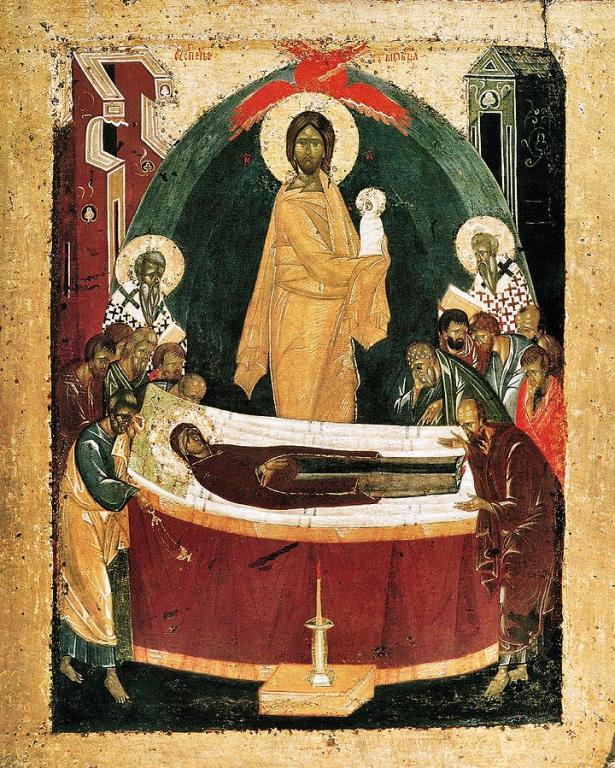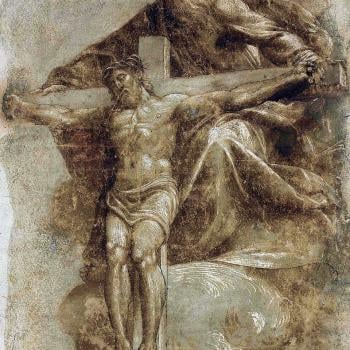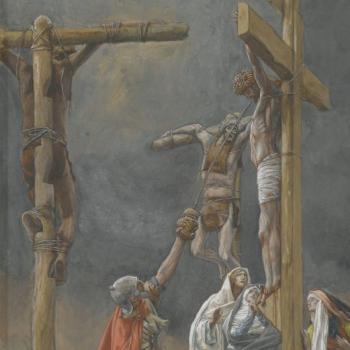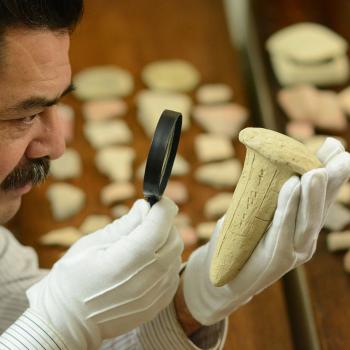
The last entry engaged the subject of Mary’s Assumption or exaltation to heaven at the end of her life. August 15th marks this event in the church calendar. Mary’s dormition, derived from the Latin word dormire, which means “to sleep”), focuses on her death. The Orthodox honor the end of Mary’s life on August 15th. The date also marks for the Eastern Church Mary’s subsequent resurrection and assumption. One source provides a good summary of Mary’s dormition and how the Eastern and Western church place emphasis on different aspects of Mary’s life’s culmination:
Catholics of the Latin tradition often assume that Mary’s final end has been sufficiently addressed by the dogma of the Assumption, that is, her translation, body and soul, into heaven as defined by Pius XII in 1950. But as glorious as the mystery of her Assumption is, it represents only one dimension of the mystery of the end of Mary’s life. There is also her death and subsequent resurrection. On this subject, Pope Pius remained silent, choosing not to address the subject of Mary’s mortality. The Byzantine tradition, however, as part of the universal and fully Catholic patrimony of the Church, is not silent on this topic. It guards a rich treasury of teaching, iconography, and liturgy concerning the end of Mary’s life.
According to the tradition of the Byzantine East, the Assumption was the final stage of Mary’s transition into the glory of heaven. This Analepsis or “translation” of Mary to eternal life was preceded by what was called the Koimesis or “sleep” or Mary in death. These three events—her death, her resurrection, and her assumption into heaven—complete the mosaic of the holy end of Mary’s life…
The interested observer may come away asking whether there is enough import with Mary’s dormition to lose sleep over it. It all depends on one’s tradition and perspective.
As was stated in the last entry, many Protestants will lose sleep over any significant role being awarded to Mary other than her being a virgin and the mother of Jesus. They may not appreciate either the title “Mother of God” taken from theotokos, which can also be translated “God bearer.” But as was briefly noted in the article on Mary’s assumption, the claim that Mary is the Mother of God says as much about Jesus’ identity as it does about Mary’s status. The idea that she bore God signifies that Jesus’ deity and humanity are not separate from one another, as with Nestorianism, which teaches that Jesus is constituted of two natures and two persons. Rather, as articulated in Chalcedonian Christology, there is one person, who has two natures—one divine and one human. Thus, theotokos signifies that Mary bore in her womb the second person of the eternal Trinity who became human.
Some Roman Catholics may lose sleep over the idea of Mary’s Dormition in keeping with Pope Pious XII’s determination to remain silent on Mary’s mortal state, as specified above in the quotation. These Catholics may wish to focus on her exalted state at the culmination of life, which they may feel is jeopardized by emphasizing to any degree her mortality.
For the Orthodox, the Dormition is worth losing sleep over in that it is part and parcel of the culmination of Mary’s life, and in the mind of some, key to maintaining the distinction between Jesus and his mother. According to Orthodox New Testament scholar John Breck,
In our Orthodox tradition we are usually very careful to distinguish between the “Dormition” of the Mother of God and her “Assumption” into heaven. The former, we feel, is properly Orthodox, while the latter strikes us as a purely Western designation, derived from a Roman Catholic “misunderstanding” of the meaning of this feast, celebrated universally on August 15.
It is true that some very genuine yet misguided interpretations of Mary’s death and exaltation can be found both in Catholic spiritual writings and in contemporary Western icons: a tendency, for example, to exalt the Holy Virgin to a level of “divinity” that effectively erases the crucial and absolute distinction between human and divine life. Orthodox theologians will insist that the “deification” (theôsis) known by the Mother of God in no way involves an ontological transformation of her being from created humanity to divinity. She was and will always remain a human creature: the most exalted of all those who bear God’s image, yet always a human being, whose glory appears in her humility, her simple desire to “let it be” according to the divine will.
While Roman Catholicism will certainly beg to differ with Fr. Breck’s judgment of a “tendency” to erase the fundamental distinction between God and humanity in Mary’s case, it is also worth noting that Breck along with other Orthodox also wish to highlight Mary’s resurrection and exaltation to heaven by her Son Jesus. She becomes the “first fruits” of the eschatological fulfilment for the new humanity in Jesus.
In a discussion of this important day in the Orthodox Church, along with the icon representing the dormition, the Greek Orthodox Archdiocese of America claims,
This great Feast of the Church and the icon celebrates a fundamental teaching of our faith—the Resurrection of the body. In the case of the Theotokos, this has been accomplished by the divine will of God. Thus, this Feast is a feast of hope, hope in Resurrection and life eternal. Like those who gathered around the body of the Virgin Mary, we gather around our departed loved ones and commend their souls into the hands of Christ. As we remember those who have reposed in the faith before us and have passed on into the communion of the Saints, we prepare ourselves to one day be received into the new life of the age to come.
We also affirm through this Feast as we journey toward our heavenly abode that the Mother of God intercedes for us. Through Christ she has become the mother of all of the children of God, embracing us with divine love.
Whether we fall asleep unto death to be raised later, or transfigured if we are alive at the Lord’s appearing, we can take hope in knowing that Jesus’ Mother awaits us as the Mother of all the church. We can also take comfort in knowing that she along with others in the great cloud of witnesses (Hebrews 12:1) cheer us on until the day when our faith becomes sight.
The next entry on the church calendar will address this great cloud of witnesses that extends throughout time (diachronic) as well as the community of faithful witnesses that extends across the globe at this time (synchronic).












